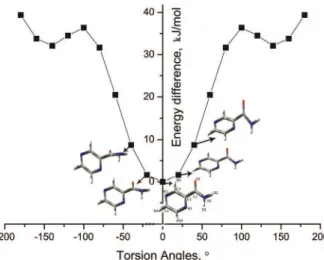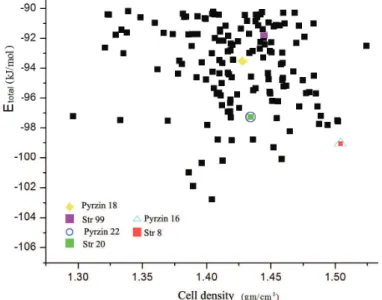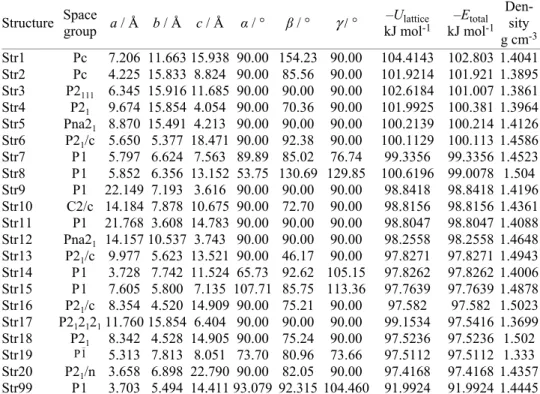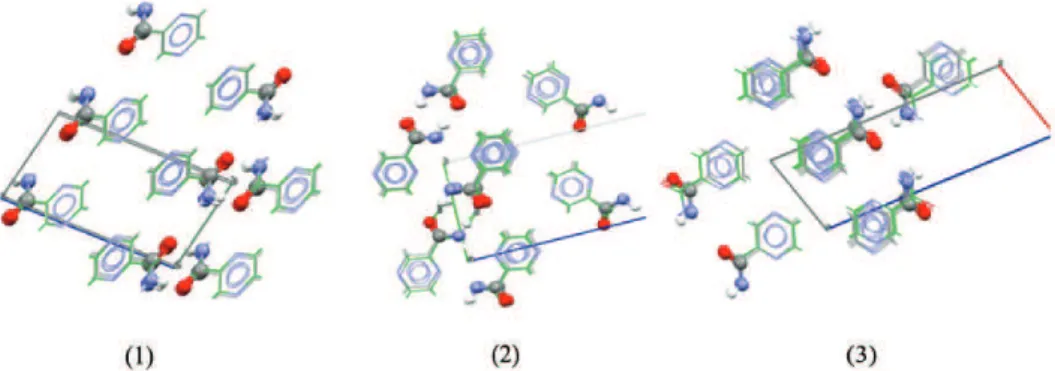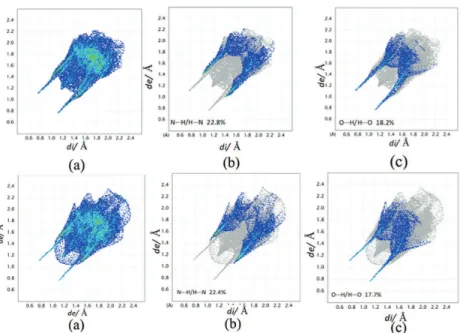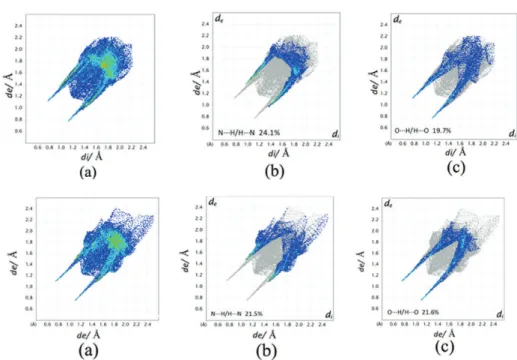JSCS–4884 Original scientific paper
Ab initio
prediction of the polymorphic structures of
pyrazinamide – A validation study
DAVID STEPHEN ARPUTHARA1*, PALLIPURATH VELEELATH NIDHIN1 and PONNUSAMY SRINIVASAN2
1
Department of Physics, Sri Shakthi Institute of Engineering and Technology, Coimbatore, India; 2Department of Physics, C. Kandaswami Naidu College for Men,
Anna Nagar, Chennai, India
(Received 10 December, revised 15 March, accepted 7 April 2016)
Abstract: A validation study to predict the possible stable polymorphs of
pyrazinamide within the low energy conformational region of the flexible torsion angle was performed through a potential energy surface (PES) scan by gas phase optimisation using the MP2/6-31G(d,p) method. Hypothetical crystal structures with favourable packing density for each of the stable conformers generated from the PES scan were generated using a global search with a repulsion only potential field. The densest crystal structures with stable energy were analyzed with more accurate lattice energy minimisation via distributed
multipole analysis using the repulsion–dispersion potential. The stability of the predicted crystal structures with similar close packing to the known experi-mental polymorphs of the pyrazinamide molecule were analyzed by inspecting their intermolecular short contacts. Studies to analyze the second derivative mechanical properties from the Hessian matrix were realised to emphasise the thermodynamic stability of predicted polymorphs of pyrazinamide.
Keywords: Ab initio crystal structure prediction; polymorphs; PES scan; lattice
energy minimisation; Hirshfeld surface.
INTRODUCTION
Polymorphism is the property of a molecule that describes its ability to
crys-tallise in more than one crystal form. Theoretical work to identify the
poly-morphs is a subject of great academic and industrial importance, since the
experi-mental observation of certain polymorphs is sometimes very challenging.
Poly-morphic structures can have similar or very different chemical and physical
pro-perties from the parent structure,
1which may alter, for example, their
pharma-ceutical effectiveness
.
Typical investigations to find the polymorphic landscapes
are performed experimentally, but theoretical predictions can reduce the process
time with much accuracy. As a result, techniques to predict crystal structures
have been introduced and tested for various molecules. Recently, in a report on
the fifth blind test, Price
et al.
analyzed the polymorphic hydrate gallic acid
monohydrate
2by refining the search space to a more manageable level by
iden-tifying the flexible torsions. Most of the crystal structure prediction (CSP)
tech-niques assume that the stable polymorphs come in the lowest energy region of
lattice-energy surface.
3Interesting and challenging tests for
ab initio
CSP techniques are the extent
to which they can predict the polymorphs of the same crystal compositions. The
current paper presents an attempt to predict the polymorphic structures of
pyra-zinamide, within a flexible torsion range and a specific potential field.
Pyrazin-amide is an antitubercular drug molecule, which can shorten the therapy to 6–9
months and has a better effect over semi-dormant bacilli.
4The concerned
pyra-zinamide molecule has four known polymorphic forms,
α
, ,
and
δ
.
5The
structural reports of these known polymorphs revealed that the two-dimensional
sheet-like appearance of the polymorph contributes to a herring bone motif, and
similar can be observed for the
δ
polymorph; whereas the
α
and
δ
forms exist as
simple sheet structures.
6Detailed analysis of the intermolecular short contacts of
the four polymorphic forms indicated the presence of a dimer interaction between
the carboxylic and the amide functional group, which was absent for the
poly-morph. The presence of strong π…π stacking for the
polymorph causes the
crystal structure to create face–face stacks whereas an edge–face interaction was
exhibited by the
δ
polymorph.
7Studies of these structures showed that the known
polymorphic forms arose from deviation in the short contacts and the hydrogen
bond motifs that may affect the solubility of the pyrazinamide molecule, which in
turn is one of the favourable qualities of a pharmaceutical compound. As
exp-lained, the presence of polymorphic structures may change the physical and
chemical properties of molecules, and may alter their medicinal value. Thus the
need for
ab initio
CSP techniques to predict the polymorphs of different organic
molecules justifies its importance.
AB INITIO METHODOLOGY
The crystal structure prediction methodology for flexible molecules exhibiting conform-ational polymorphism should evaluate and compare the relative energy penalty for the intramolecular distortion of the molecule to verify its stability using Eq. (1):
Etotal = Ulattice + ΔEintra (1)
The commonly used ab initio CSP method starts with a potential energy surface scan
with a flexible torsion angle and global search to identify the likely crystal structures within the crystal energy landscape. The selected best crystal structures were then subjected to lattice energy minimisation. The same methodology was used in the current paper with the potential energy surface scan executed using the MP2 method with the 6-31G(d,p) basis set in Gaussian
crystal energy landscape was realised by performing step-by-step orientations of the con-cerned molecule in all common coordination geometries for constructing the appropriate coordination patterns with the unit cell volume as the function to be minimised. The algorithm uses a repulsion only UMD potential to build the packing arrangements in the commonly encountered space groups P1, P1 , P2, Pm, Pc, P21, P2/c, P21/m, P2/m, P21/c, Cc, C2, C2/c, Pnn2, Pba2, Pnc2, P221, Pmn21, Pma2, P212121, P21212, Pca21, Pna21, Pnma and Pbca. The densest hypothetical packings generated from the MOLPAK search were then subjected to more accurate lattice energy minimisation using DMACRYS,10 which implements a repul-sion–dispersion potential field of the form:
U= Σiє1kЄ2 [(AiiAkk)1/2]exp[–(Bii + Bkk)Rik/2]–(CiiCkk)1/2/R6ik (2)
where i and k are the atoms in molecules 1 and 2 of different types. The parameters used in
this study came from the FIT potential, parameterized by Williams and Cox,11 with additional terms for the hydrogen atoms bound to nitrogen later fitted by Coombes et al.12
The thermodynamic stability of predicted crystal structures was verified from the second derivative properties from the DMACRYS optimization by confirming the Born stability criteria were met. The eigenvalues of the final optimized structure were evaluated for all the representations of the group to find the occurrence of any negative eigenvalues. The presence of negative eigenvalues indicates that the structure had been optimized to a saddle point between two lower symmetry structures. A valid minimisation can be performed in such cases by re-minimising the optimized structure after removing the corresponding representation of space group from the symmetry constraints to attain the true minimum.
In the next section, a detailed outline of the employed approach towards pyrazinamide is provided.
Potential energy surface scan with flexible torsion
The conformational diversity of a molecule increases with increasing number of flexible torsion angles,13 and hence, the potential energy surface of flexible molecules which form different conformational structures should be analyzed.14 The aim of this stage was to find the local minima of the low energy conformers within the energy landscape by performing a potential energy surface scan with a selected flexible torsion angle (θ), the variation of which plays a vital role in producing conformational polymorphism. A potential energy surface scan executed through a series of MP2 level gas phase optimizations gives detailed analysis of possible conformers of the molecule of interest and the energy barrier associated with the conformational changes of the flexible molecule and thereby locating local minima,15 which is crucial for the prediction methodology.
the terminal nitrogen atom (N(1)] being cis to the ring nitrogen [N(3)), thereby enabling a
strong intramolecular hydrogen bonding interaction. Two shallow troughs in the plot were found at the near trans position of N(1) and N(3) making a torsion angle of ≈140°. The stable
conformers generated in the PES scan of the selected torsion angle were analyzed and those within an energy range of ≈10 kJ mol–1 of the global minimum16 were selected for the MOLPAK global search. The selected conformers had the cis configuration of the key
aro-matic nitrogen with the terminal nitrogen atom, and a torsion angle ranging from –40 to 40°. All the other structures were not considered since they were found to be at higher regions of the energy plot and thus, it was very unlikely that the intermolecular energy could overcome the energy penalty for deformation of the molecule from the global minimum.
Fig. 1. Graph of energy difference vs. the torsion angle N(3)–C(2)–C(1)–N(1).
MOLPAK global search for the crystal structures
The prior background aim of the global search is to generate all the possible hypothetical dense structures with various space group symmetry within the lattice energy surface. All the generated structures within a specific space group were then optimized with the boundary values of decision variables like lattice lengths, lattice angles and Euler's coordinates which determine and specify the geometry of the unit cell. The optimized structures with calculated density less than the threshold density were taken as one of the possible crystal structures.
DMACRYS lattice energy minimisation and selection of the final structures
The hypothetical densest rigid molecule crystal structures generated from the global search were selected as the starting points for the lattice energy minimisations to evaluate their thermodynamic stability using the DMACRYS algorithm, which incorporates a repulsion dispersion potential field of the form Eq. (2). The electrostatic and intramolecular interactions of the molecules were modelled through a set of atomic dipoles evaluated from a distributed multipole analysis of the MP2/6-31G(d,p) charge density using the GDMA algorithm.18
The DMACRYS lattice energy minimisation of the hypothetical rigid molecule crystal structures calculates the Ewald summed charge–charge, charge–dipole, dipole–dipole inter-actions19 and the second derivative properties from the Hessian matrix to emphasise their stability and valid minimisation. The structures that had not reached true minima were at a transition state, which will reach true minima in further lattice minimisation within the interaction field. For pyrazinamide, it was noted that some of the crystal structures failed to reach true minima, generating non-zero eigenvalues for the coordination symmetry. Therefore repeated minimisation was done for such crystal structures to attain true minima, by removing the non-zero representation from the symmetry constraints.
Fig. 2. The crystal energy landscape showing all the possible predicted stable crystal structures of the pyrazinamide molecule along with the minimised experimental
pyrzin 16 (δ), pyrzin 22 (α) and pyrzin 18 ( ) polymorphs.
RESULTS AND DISCUSSION
Analysis of the predicted conformers
The hypothetical crystal structures from the crystal energy landscape were
sorted in increasing order of the total energy (
E
total). The most stable structures
from the landscape predicted
via
the
ab initio
crystal structure prediction method
are presented in Table I. The structures that almost matched the experimental
crystal were selected based on the root mean square deviation (
RMSD
) for the
crystal packing similarity. The lowest energy optimized crystal structures could
be considered as potential polymorphs of pyrazinamide.
TABLE I. List of lowest energy conformers identified via ab initio CSP together with the
reproduced experimental polymorphs (δ, α and ) of pyrazinamide
Structure Space group a / Å b / Å c / Å α / ° / ° γ / ° kJ mol–Ulattice-1 kJ mol–Etotal -1
Den-sity g cm-3 Str1 Pc 7.206 11.663 15.938 90.00 154.23 90.00 104.4143 102.803 1.4041 Str2 Pc 4.225 15.833 8.824 90.00 85.56 90.00 101.9214 101.921 1.3895 Str3 P2111 6.345 15.916 11.685 90.00 90.00 90.00 102.6184 101.007 1.3861 Str4 P21 9.674 15.854 4.054 90.00 70.36 90.00 101.9925 100.381 1.3964 Str5 Pna21 8.870 15.491 4.213 90.00 90.00 90.00 100.2139 100.214 1.4126 Str6 P21/c 5.650 5.377 18.471 90.00 92.38 90.00 100.1129 100.113 1.4586 Str7 P1 5.797 6.624 7.563 89.89 85.02 76.74 99.3356 99.3356 1.4523 Str8 P1 5.852 6.356 13.152 53.75 130.69 129.85 100.6196 99.0078 1.504 Str9 P1 22.149 7.193 3.616 90.00 90.00 90.00 98.8418 98.8418 1.4196 Str10 C2/c 14.184 7.878 10.675 90.00 72.70 90.00 98.8156 98.8156 1.4361 Str11 P1 21.768 3.608 14.783 90.00 90.00 90.00 98.8047 98.8047 1.4088 Str12 Pna21 14.157 10.537 3.743 90.00 90.00 90.00 98.2558 98.2558 1.4648 Str13 P21/c 9.977 5.623 13.521 90.00 46.17 90.00 97.8271 97.8271 1.4943 Str14 P1 3.728 7.742 11.524 65.73 92.62 105.15 97.8262 97.8262 1.4006 Str15 P1 7.605 5.800 7.135 107.71 85.75 113.36 97.7639 97.7639 1.4878 Str16 P21/c 8.354 4.520 14.909 90.00 75.21 90.00 97.582 97.582 1.5023 Str17 P21212111.760 15.854 6.404 90.00 90.00 90.00 99.1534 97.5416 1.3699 Str18 P21 8.342 4.528 14.905 90.00 75.24 90.00 97.5236 97.5236 1.502 Str19 P1_ 5.313 7.813 8.051 73.70 80.96 73.66 97.5112 97.5112 1.333 Str20 P21/n 3.658 6.898 22.790 90.00 82.05 90.00 97.4168 97.4168 1.4357 Str99 P1 3.703 5.494 14.411 93.079 92.315 104.460 91.9924 91.9924 1.4445
struc-tures similar to the experimental polymorphs of pyrazinamide successfully
valid-ates the generated landscape. No optimized crystal structures with similar
pack-ing to the experimental
polymorph of pyrazinamide were generated in the
land-scape, probably because this structure is in a disordered form in the CSD database.
Fig. 3. Overlay of: 1) Str8 (blue) with the experimental form (green), 2) Str20 (blue) with experimental form (green) and 3) Str99 (blue) with experimental form (green).
TABLE II. Reproduction of the observed crystal structures of pyrazinamide using the experimental conformation (Expminexp) and the matching structures (20 molecules in common) found during the search of the optimized conformations
Conformation a / Å b / Å c / Å α / ° / ° γ / ° Density g cm-3 kJ mol–Etotal-1 Pyrzin16 (δ)
observed 5.119 5.705 9.857 97.460 98.170 106.470 – – Expminexp 5.194 5.852 9.803 97.924 97.789 110.040 1.5041 99.05 Expminopt 5.852 6.356 13.152 53.749 130.686 129.849 1.504 99.01 Pyrzin22 (α)
observed 3.617 6.741 22.463 90.000 92.390 90.000 – – Expminexp 3.617 6.714 22.463 90.000 92.395 90.000 1.4354 97.47 Expminopt 3.658 6.898 22.790 90.000 82.050 90.000 1.4357 97.42 Pyrzin18 ( )
observed 3.624 10.616 14.315 90.000 101.120 90.000 – – Expminexp 14.021 3.791 10.953 90.000 100.402 90.000 1.4280 93.55 Expminopt 3.703 5.494 14.411 93.079 92.315 104.460 1.4445 91.99
The comparative analysis shown in Table II indicates that the optimized
hypothetical structures were generated at equivalent total energies with respect to
those of the reproduced experimental polymorphs of pyrazinamide, thereby
con-firming the similarity. As mentioned in the previous report,
21there was a
dis-crepancy between the polymorph (Pyrzin 18) at 0 K and its CSP generated
equivalent.
The similarity in the patterns confirmed the optimized structures Str8, Str20 and
Str99 resemble those of the
δ
,
α
and polymorphs, respectively.
Intermolecular short range contacts of rigid molecules are of vital
import-ance to their thermodynamic stability and strong packing. Since the stability of
well packed crystal structures is a result of hydrogen bond interactions, the graph
sets and key hydrogen bond motifs of the theoretical and experimental crystal
structures of pyrazinamide were analysed to explain the structural stability. The
analysis demonstrated that the predicted crystal structures Str8, Str20 and Str99
replicate the hydrogen bond interactions of the δ,
α
and polymorphs of
pyrazin-amide. Detailed inspection of the structures showed that the experimental δ
andpolymorphs formed a ring type R
22(8) hydrogen bond motif, whereas the
experi-mental
α
polymorph was stabilised by two ring type motifs, R
22(8) and R
22(10),
and three chain type C
22(9), C
22(7) and C
22(16) motifs (Table III). It should be
noticed that these ring types are explicitly H-bonded dimers which include N(1)
as the donor and N(3)/O(1) as acceptors (N(1)–H(2)…O(1) and N(1)–H(1)…N(3),
see Fig. 1 for the atomic numbering); whereas the chain type hydrogen bonds
give rise to a zig-zag manner of interaction, with the same donor–acceptor pairs of
atoms as for the case of both the experimental and the corresponding predicted
α
polymorphs. The similarity in the short intermolecular contacts between the
experimental and theoretical crystal structures with the same donor acceptor pairs
of atoms revealed that Str8, Str20 and Str99 resemble the experimental δ ,
α
and
polymorphs, respectively, with low
RMSD
values (Table III).
TABLE III. List of the common graph sets for the experimental polymorphs and corresponding abinitio predicted crystal structures
Conformer
label Hydrogen bond motif EDeviation in total, kJ mol-1
RMSD Experimental polymorph
Str8 R22(8) 0.0754 0.217 δ
Str20 R22(8) R22(10) C22(7) C22(9) C44(16) 0.0494 0.321 α
Str99 R22(8) 1.5574 1.098 β
From the COMPACK comparison exhibiting the low
RMSD
values and the
hydrogen bond motif analysis, it is clear that the predicted crystal structures,
Str8, Str20 and Str99, with
E
totalvalues of –99.01, –97.4 and –91.9 kJ mol
–1,
respectively, are in good agreement with the
δ,α
and
polymorphs of
pyrazin-amide with the same hydrogen bond network that stabilizes the structure.
Ther-modynamic stability and mechanical strength were analyzed from the
C
ijmat-rix,
22which indicates that the crystal structures met the Born criteria of stability.
The estimated mechanical properties of the predicted structures are presented in
Table IV.
TABLE IV. Comparison of the mechanical properties of the ab initio predicted crystal
structures and the minimised experimental polymorphs of pyrazinamide Structure/
Label Diagonal elements of elastic stiffness tensor matrix,
Cij Young’s
modulus, GPa
C11 C22 C33 C44 C55 C66
δ 42.15949 37.22293 56.43596 12.98786 31.09893 12.31457 34.80518 Str8 32.93377 70.05573 26.60066 26.68087 15.79472 16.98622 34.79503 α 21.3624 48.63952 50.55721 23.50807 8.76284 13.58747 32.05085 Str20 21.2048 48.76925 51.25284 23.87522 8.47534 13.15296 32.06417 β 82.43099 19.57472 40.87375 8.44669 12.50882 16.82628 32.54519 Str99 28.51313 18.95646 99.67113 7.88322 13.27796 8.63193 26.30433
Hirshfeld finger print plot analysis
An investigation of the intermolecular short contacts for the
ab initio
pre-dicted polymorphs of pyrazinamide was performed by analyzing the 2D
finger-print plots for each structure
23generated using Crystal Explorer.
24The
finger-print plots for each predicted polymorph showed two distinct spikes at the lower
d
i/d
eregion indicating the presence of N…H/H…N and O…H/H…O
intermole-cular short contacts. As the oxygen atom is more electronegative than the
nitro-gen atom, the interaction was found to be stronger in structures containing
O…H/H…O. A comparative analysis of the intermolecular short contacts between
the experimental and predicted polymorphs of pyrazinamide revealed the similar
nature of the interactions with the N(1) atom at the terminal bond being the donor
atom. The 2D fingerprint plots with resolved and unresolved short contacts of the
experimental and predicted polymorphs of pyrazinamide are shown in Figs. 5–7.
Figures 5–7 show the 2D finger print plots for the experimental
pyrazin-amide polymorphs,
δ,α
and
β
,
together with the corresponding optimized
struc-tures, Str8, Str20 and Str99, respectively, with resolved and unresolved short
contacts. It could be seen that the structures were stabilized through N…H/H…N
and O…H/H…O intermolecular contacts. The former interaction was found to
contribute the major percentage to the Hirshfeld surface, indicating its vital
imp-ortance for both experimental and theoretically predicted structures. It could be
observed that the greater electronegativity of the oxygen atom makes the spike
more pointed to the low
d
i/d
eregion for all the experimental and predicted
structures, indicating the O…H/H…O interaction.
Fig. 5. 2D finger print short contact plots of the experimental δ polymorph (first row) and Str8 (second row) with (a) 100 % contribution of all atoms to the Hirshfeld surface, (b) resolved
N…H/H…N interactions and (c) resolved O…H/H…O interactions.
Fig. 6. 2D finger print short contact plots of the experimental α polymorph (first row) and Str20 (second row) with (a) 100 % contribution of all atoms to the Hirshfeld surface, (b)
Fig. 7. 2D finger print short contact plots of the experimental β polymorph (first row) and Str99 (second row) with (a) 100 % contribution of all atoms to the Hirshfeld surface, (b)
resolved N…H/H…N interactions and (c) resolved O…H/H…O interactions.
The resolved and unresolved contributions of each key interaction with
respect to their experimental polymorphs are tabulated in Table V.
TABLE V.The percentage contributions of the key interactions for both experimental and the corresponding theoretical structures
Interaction exp δ/ Str8 exp α / Str20 exp / Str99
N…H / H…N 22.8 / 22.4 26.1 / 25.3 24.1 / 21.5
O…H / H…O 18.2 / 17.7 18.3 / 18.5 19.7 / 21.6
The data included in Table V show the percentage contribution of the key
interactions for both the experimental and their corresponding optimised
con-formers. An analysis of the data from Table III indicates that the structures called
Str8, Str20 and Str99 are the experimental
δ,α
and polymorphs of
pyrazin-amide generated in the energy landscape and thereby justifies the thermodynamic
stability of the optimized structures.
CONCLUSIONS
con-formers was found to be densely populated. Lattice energy minimisation of the
lowest energy structures was performed incorporating the distributed multipole
charges. The unique optimized crystal structures were refined and studied
thoroughly. The stability of the selected structures was verified by analyzing the
intermolecular interactions and second derivative mechanical properties,
con-firming that the structures had achieved the Born criteria of stability. Detailed
analysis of the hydrogen bonds showed that Str8, Str20 and Str99 had similar
interactions to the
δ,α
and
β
polymorphs of pyrazinamide indicating their
physic-ally favourable nature. The Hirshfeld 2D fingerprint plot analysis of the predicted
polymorphs revealed that the majority of the interactions are made by the amide
and carboxylic group of the molecule, providing a major contribution to the
Hirshfeld surface, thereby achieving the stability. The favourable results from the
studies made for the theoretical crystal structures of pyrazinamide justify the
sel-ected flexible torsion angle and the potential field used for the current prediction
methodology. The similarities of the optimized structures with respect to the
experimental known polymorphs of pyrazinamide proved the authenticity of the
generated energy landscape. Thus the lower energy optimized theoretical
struc-tures of pyrazinamide generated
via
the current prediction method in the energy
landscape could be considered as potential polymorphs of pyrazinamide, which
are resolved or yet to be resolved, thereby the current methodology was validated.
Acknowledgements. The authors are grateful to Dr. Louise S. Price for her kind help and
support in using the DMACRYS package software and associated programs, and for assist-ance in the preparation of this manuscript. The authors are also grateful to DST-SERB for providing financial assistance and support for this research work, carried out under the young scientist fast track project.
И З В О Д
AB INITIOПРЕДВИЂАЊЕПОЛИМЕРНИХСТРУКТУРАПИРАЗИНАМИДА
СТУДИЈАВАЛИДАЦИЈЕ
DAVID STEPHEN 1, P.V. NIDHIN1и P. SRINIVASAN2
1Department of Physics, Sri Shakthi Institute of Engineering and Technology, Coimbatore, India; 2Department of Physics, C. Kandaswami Naidu College for Men, Anna Nagar, Chennai, India
Скенирањемповршинепотенцијалнеенергије (PES) добијенеоптимизацијомугас
-нојфазипомоћу MP2/6-31G(d,p) методе, урађенајестудијавалидацијезапредвиђање
могућихстабилнихполиморфа пиразинамидауобластиконформацијанискеенергије
зафлексибилниторзиониугао. Генерисанесухипотетичнекристалне сруктуресапо
-вољномгустиномпаковањазасвакиодстабилнихконформеракоједаје PES користећи
глобалнупретрагусамопољаодбојногпотенцијала. Најгушћекристалнеструктуреста
-билне енергије су анализиране поузданијом минимизацијом енергије решетке путем
дистрибуиране мултиполне анализе користећи репулзионо-дисперзиони потенцијал.
Стабилностпредсказанихструктурасасличнимпаковањемкаоиексперименталнопоз
-нати полиморфи пиразинамида, анализирани су испитивањем њихових блиских кон
-таката. УрађенајеанализадругихизводамеханичкихособинанаосновуХесовематрице
какобисенагласилатермодинамичкастабилностпредсказанихполиморфапиразинамида.
REFERENCES
1. M. Vasileiadis, A. V. Kazantsev, P. G. Karamertzanis, C. S. Adjiman, C. C. Pantelides,
Acta Crystallogr., B68 (2012) 677
2. D. A. Bardwell, C. S. Adjiman, Y. A. Arnautova, E. Bartashevich, S. X. M. Boerrigter, D. E. Braun, A. J. Cruz-Cabeza, G. M. Day, R. G. Della Valle, G. R. Desiraju, B. P. van Eijck, J. C. Facelli, M. B. Ferraro, D. Grillo, M. Habgood, D. W. M. Hofmann, F. Hof-mann, K. V. J. Jose, P. G. Karamertzanis, A. V. Kazantsev, J. Kendrick, L. N. Kuleshova, F. J. J. Leusen, A. V. Maleev, A. J. Misquitta, S. Mohamed, R. J. Needs, M. A. Neumann, D. Nikylov, A. M. Orendt, R. Pal, C. C. Pantelides, C. J. Pickard, L. S. Price, S. L. Price, H. A. Scheraga, J. van de Streek, T. S. Thakur, S. Tiwari, E. Venuti, I. K. Zhitkov, Acta Crystallogr., B67(2011) 535
3. G. M. Day, Crystallogr. Rev. 17 (2011) 3
4. G. Shadeed, Int. J. Pharm. Pharm. Sci.7 (2015) 581
5. Y. Takaki, Y. Sasada, T. Watanabe, Acta Crystallogr.13(1960) 693
6. G. Ro, H. Sorum, Acta Crystallogr., B28 (1972) 991
7. Y.-H. Luo, Q.-L. Liu, L.-J. Yang, W. Wang, Y. Ling, B.-W. Sun, Res. Chem. Intermed. 41 (2015) 7059
8. Gaussian 09, Revision D.1, Gaussian, Inc., Wallingford, CT, USA, 2009 9. J. R. Holden, Z. Du, H. L. Ammon, J. Comput. Chem. 14(1993) 422
10. S. L. Price, M. Leslie, G. W. A. Welch, M. Habgood, L. S. Price, P. G. Karamertzanis, G. M. Day, Phys. Chem. Chem. Phys.. 12(2010) 8478
11. D. E. Williams, S. R. Cox, Acta Crystallogr. B 40 (1984) 404
12. D. S. Coombes, S. L. Price, D. J. Willock, M. Leslie, J. Phys. Chem. 100 (1996) 7352
13. Z. F. Weng, W. D. S. Motherwell, F. H. Allen, J. M. Cole, Acta Crystallogr. B64(2008)
348
14. C. Ouvrard, S. L. Price, Cryst. Growth Des. 4(2004) 1119
15. H. Nowell, S. L. Price, Acta Crystallogr. .B61(2005) 558
16. H. P. G. Thompson, G. M. Day, Chem. Sci.5 (2014) 3173
17. H. L. Ammon, Z. Du, J. R. Holden, L. A. Paquette, Acta Crystallogr. B50(1994) 216
18. A. J. Stone, GDMA, University of Cambridge, Cambridge, 1999 19. P. P. Ewald, Ann. Phys. (Berlin, Ger.) 369(1921) 253
20. J. A. Chisholm, S. Motherwell, J. Appl. Crystallogr. 38(2005) 228
21. N. Wahlberg, P. Ciochon, V. Petrick, A. O. Madsen, Cryst. Growth Des.14 (2014 ) 381
22. A. T. Anghel, G. M. Day, S. L. Price, CrystEngComm4(2002) 348
23. S. Madan Kumar, B. C. Manjunath, G. S. Lingaraju, M. M. M. Abdoh, M. P. Sadasiva, N. K. Lokanath, Cryst. Struct. Theory Appl.2(2013) 124
